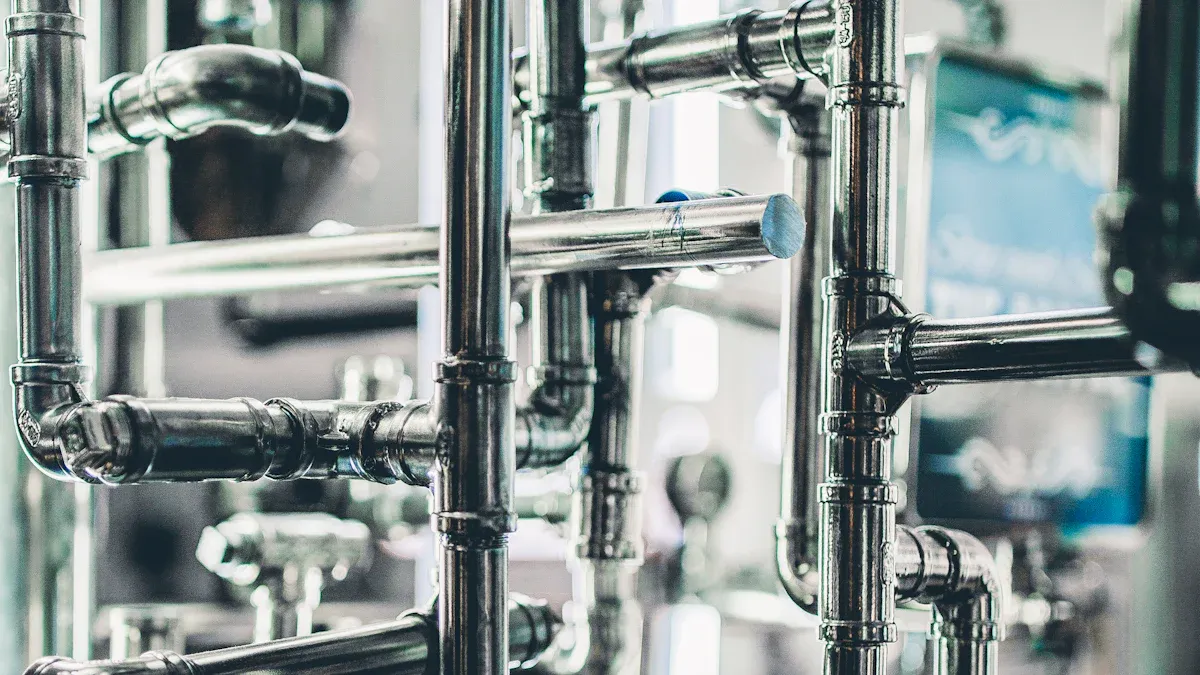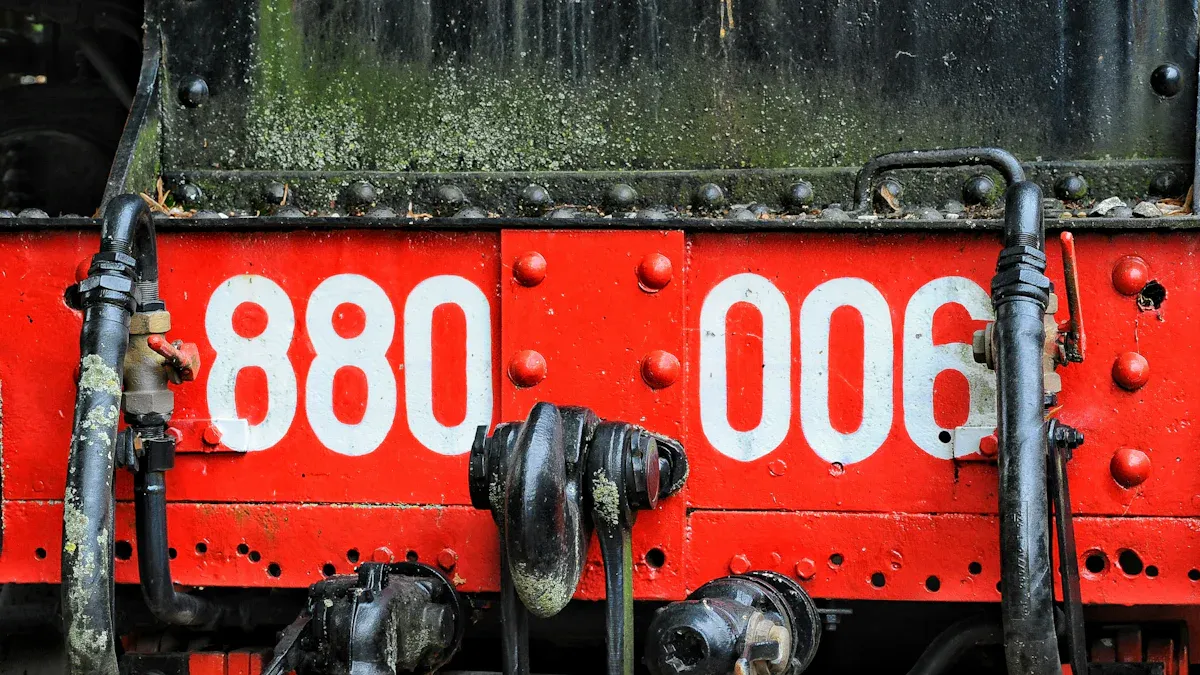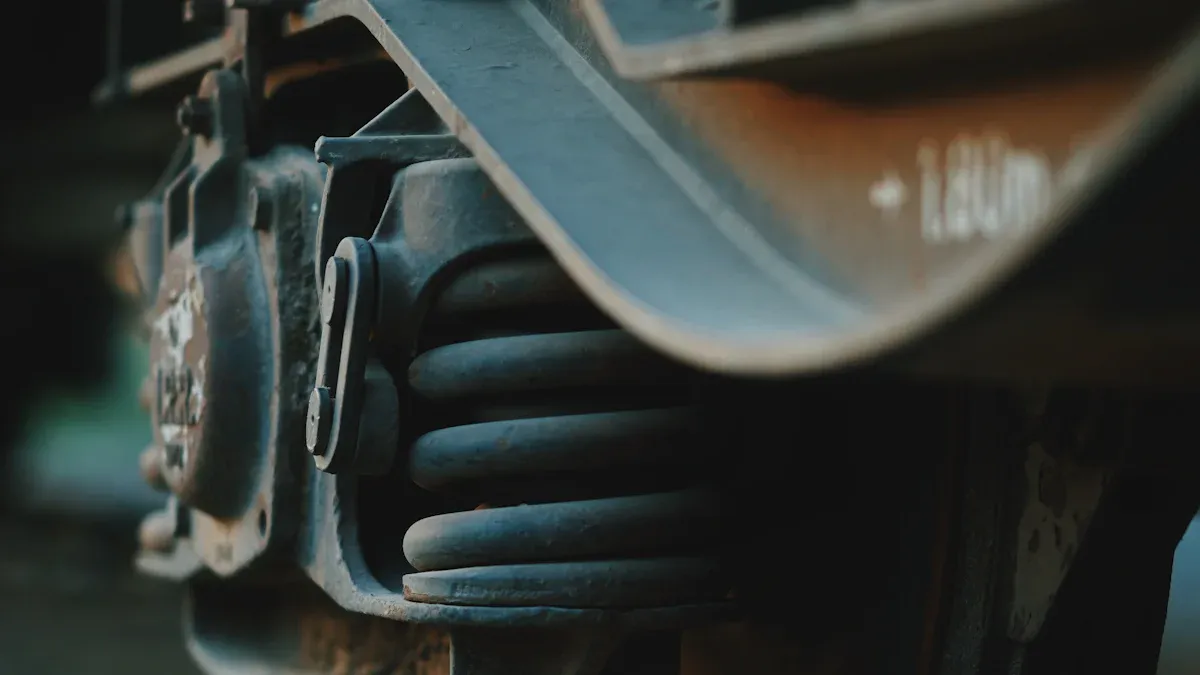
Stainless steel precision castings for train fittings are revolutionizing the railway industry in 2025. These steel castings provide unparalleled precision, enhancing energy efficiency and mechanical performance. The lightweight yet robust design of stainless steel cast parts improves acceleration and braking while minimizing track wear. Their superior corrosion resistance ensures durability in harsh environments, significantly reducing maintenance expenses. With outstanding wear resistance, stainless steel precision castings, train fittings contribute to fewer failures, increasing safety and reliability across the board.
Technological Advancements in Stainless Steel Precision Castings

Adoption of 3D Printing for Mold Creation
3D printing has transformed how molds are created for stainless steel precision castings for train fittings. This technology enables manufacturers to produce intricate geometries and lightweight structures without increasing costs. By eliminating the need for traditional tooling, 3D printing reduces production expenses and speeds up the process. Functional parts can now be ready in just days, making it ideal for prototypes or small production runs.
Another advantage is the reduction of material waste. 3D printers use only the necessary amount of material, which aligns with sustainability goals. Additionally, the ability to create strong, integrated parts with fewer weak points enhances the durability of train fittings. On-demand manufacturing also minimizes the need for large inventories, offering flexibility to meet changing demands.
Integration of CNC Machining for Complex Components
CNC machining plays a critical role in crafting complex components for train fittings. Recent advancements, such as hybrid manufacturing, combine CNC machining with additive manufacturing. This approach allows for the creation of intricate geometries essential for modern train designs. Companies like JR Machine have demonstrated the capability to handle complex parts using advanced CNC machines, even with challenging materials like nickel-based superalloys.
Other innovations include the use of AI and machine learning to optimize machining parameters. Real-time data analysis improves precision and reduces errors during production. Augmented reality (AR) is also being used in training and operations, further enhancing accuracy and efficiency.
AI and Machine Learning in Casting Processes
AI and machine learning are revolutionizing casting processes in the railway industry. These technologies emulate expert knowledge to design high-performance castings. For example, machine learning models optimize gating systems in High Pressure Die Casting (HPDC), ensuring a smooth flow of molten metal. This reduces turbulence and improves the quality of the final product.
Manufacturers are also using machine learning to manage casting parameters. By analyzing millions of data points, they can classify product lines and validate designs. Techniques like data scaling and oversampling enhance model accuracy, making these tools versatile across various casting applications. These advancements ensure that stainless steel precision castings for train fittings meet the highest standards of quality and performance.
Lightweight and High-Performance Designs
Use of Advanced Alloys Like 304(L) and 316(L)
Advanced stainless steel alloys, such as 304(L) and 316(L), are game-changers for train fittings. These alloys offer a perfect balance of strength, corrosion resistance, and lightweight properties. For instance, 304(L) is known for its excellent weldability and durability, making it ideal for structural components. On the other hand, 316(L) stands out with its superior resistance to harsh environments, including salty or humid conditions. This makes it a preferred choice for fittings exposed to extreme weather. By using these alloys, manufacturers can create train components that last longer and perform better without adding unnecessary weight.
Enhanced Acceleration and Braking Through Lightweight Components
Lighter train fittings mean faster acceleration and more efficient braking. Stainless steel precision castings allow engineers to design components that are both strong and lightweight. This reduces the overall weight of the train, improving its energy efficiency. With less mass to move, trains can accelerate quicker and stop more effectively. This not only enhances passenger safety but also reduces wear on braking systems. Lightweight designs also contribute to smoother rides, making train travel more comfortable for everyone.
Reduction of Track Wear with Optimized Designs
Optimized designs play a crucial role in reducing track wear, especially on curved tracks. Research shows that designing asymmetric rail head profiles can minimize wear and improve dynamic performance. Additionally, certain practices help reduce stress on rails:
- Minimizing steep curves and gradients in track layouts.
- Using continuous welded rail (CWR) to eliminate joints, ensuring smoother rides.
These innovations extend the lifespan of both tracks and train components, lowering maintenance costs and improving reliability. By focusing on lightweight and optimized designs, the railway industry is setting new standards for efficiency and durability.
Sustainability in Stainless Steel Precision Castings for Train Fittings
Eco-Friendly Practices in Casting Processes
Sustainability starts with smarter manufacturing. Precision casting processes are designed to minimize waste by producing near-net shapes. This means less scrap material is generated, which reduces the environmental impact. High-strength alloys also play a role here. They create durable train fittings that last longer, cutting down on waste from frequent replacements.
Another key advantage is energy efficiency. Compared to traditional methods like forging, precision casting requires significantly less energy. This not only lowers production costs but also reduces the carbon footprint of the entire process. Many manufacturers are now adopting eco-friendly practices, such as using advanced technologies to optimize energy use and reduce emissions. These steps are helping the railway industry move toward a greener future.
Use of Recycled Stainless Steel Materials
Recycling is a game-changer in stainless steel precision castings for train fittings. By using recycled stainless steel, manufacturers reduce the need for new raw materials. This approach saves energy and lowers greenhouse gas emissions during production. Recycled metals also help conserve natural resources, making the process more sustainable.
The benefits don’t stop there. Recycled materials maintain the same high-quality standards as new ones, ensuring that train fittings remain strong and reliable. With more companies prioritizing recycled inputs, the industry is taking meaningful steps to reduce its environmental footprint while maintaining performance.
Energy-Efficient Manufacturing Techniques
Modern precision casting techniques are setting new benchmarks for energy efficiency. Processes like investment casting use advanced technologies to minimize energy consumption. Compared to forging or machining, these methods require less energy input, which directly reduces the carbon footprint of manufacturing.
Additionally, precision casting minimizes material waste. By using only what’s needed, manufacturers save costs and support sustainable practices. These energy-efficient techniques not only benefit the environment but also make the production of train fittings more cost-effective. As the industry continues to innovate, energy efficiency remains a top priority.
Customization and Design Flexibility
Tailored Solutions for Specific Train Fitting Requirements
Manufacturers are now offering tailored solutions to meet the unique needs of train operators. These customizations address specific challenges, such as terrain, climate, and regulatory requirements. For example:
- Custom wheel assemblies and braking systems improve traction and stability on rugged terrains.
- Weather-resistant materials ensure reliable performance in extreme temperatures.
- Freight trains benefit from components designed to handle heavy loads, while passenger trains feature ergonomic interiors for comfort and safety.
Advancements like 3D printing and CNC machining make these customizations possible. These technologies allow manufacturers to quickly prototype and test new designs, reducing the time from concept to deployment. Additionally, integrating smart technologies, such as IoT sensors, enhances functionality and enables proactive maintenance. This flexibility ensures that stainless steel precision castings for train fittings meet diverse operational demands.
Precision Casting for Complex Geometries
Precision casting has revolutionized the production of intricate train components. The investment casting process, in particular, allows for the creation of highly accurate and complex geometries. This method integrates multiple design elements into a single component, simplifying manufacturing and improving reliability. For train fittings, this means fewer parts, reduced assembly time, and enhanced durability. The ability to produce such detailed components ensures that even the most challenging designs can be realized without compromising quality.
Lightweight Components for Energy Efficiency
Lightweight components are essential for improving energy efficiency in modern trains. Stainless steel precision castings for train fittings enable the production of strong yet lightweight parts. These components reduce the overall weight of the train, leading to lower energy consumption and improved performance. Lighter trains accelerate faster, brake more effectively, and place less stress on tracks. This not only enhances operational efficiency but also contributes to a more sustainable railway system.
Enhanced Durability and Longevity

Corrosion-Resistant Alloys for Harsh Environments
Stainless steel precision castings excel in environments where moisture and corrosive elements are constant threats. Alloys like 316(L) provide exceptional resistance to rust and degradation, making them ideal for train fittings exposed to rain, snow, or salty air. This resistance ensures that components maintain their integrity over time, even in the harshest conditions.
Corrosion-resistant alloys not only protect against environmental damage but also reduce the need for frequent replacements. This durability translates to fewer maintenance interruptions, keeping trains running smoothly and efficiently.
Improved Strength-to-Weight Ratios
Modern train fittings demand materials that are both strong and lightweight. Stainless steel precision castings meet this need perfectly. These castings offer high strength-to-weight ratios, allowing engineers to design components that can withstand extreme stress without adding unnecessary weight.
Lighter components reduce the strain on train systems, improving fuel efficiency and overall performance. At the same time, their strength ensures safety and reliability, even under heavy loads or high-speed conditions. This balance of strength and weight makes stainless steel an indispensable material for the railway industry.
Longer Lifespan of Train Fittings
Stainless steel precision castings significantly extend the lifespan of train fittings. Their wear resistance makes them ideal for parts that endure constant friction and stress, such as wheel assemblies and braking systems. Additionally, these castings prevent moisture and corrosive elements from penetrating the material, ensuring long-term durability.
- Components maintain structural integrity under extreme conditions, enhancing safety.
- Exceptional wear resistance reduces the frequency of part replacements.
- Longer-lasting fittings lower maintenance costs and minimize unexpected breakdowns.
By investing in stainless steel precision castings, train operators benefit from reduced operational expenses and improved reliability. These durable components ensure that trains remain efficient and safe for years to come.
Industry Collaboration and Standardization
Partnerships Between Manufacturers and Rail Operators
Strong partnerships between manufacturers and rail operators drive innovation in stainless steel precision castings. These collaborations ensure that train fittings meet the specific needs of rail systems. Manufacturers often provide technical assistance, helping operators choose the best materials and designs for their requirements. This guidance simplifies decision-making and ensures optimal performance.
Clear communication plays a key role in these partnerships. Regular updates during the production process build trust and reduce misunderstandings. For example, manufacturers can share progress reports or address potential issues early. This transparency fosters confidence and strengthens long-term relationships. By working closely together, both parties can achieve better results and improve the overall efficiency of rail systems.
Development of Global Standards for Precision Castings
Global standards for stainless steel precision castings ensure consistency and quality across the railway industry. These standards define material properties, manufacturing processes, and performance benchmarks. They help manufacturers produce components that meet international requirements, making it easier for rail operators to source reliable parts.
Standardization also promotes safety. Train fittings built to global specifications are less likely to fail under stress. This reduces the risk of accidents and enhances passenger confidence. Additionally, standardized components simplify maintenance and repairs. Rail operators can replace parts quickly, minimizing downtime and keeping trains running smoothly.
Knowledge Sharing Across the Industry
Knowledge sharing accelerates progress in stainless steel precision castings. Industry events, workshops, and online forums provide platforms for manufacturers and rail operators to exchange ideas. These interactions encourage innovation and help solve common challenges.
For instance, sharing best practices in casting techniques can improve efficiency and reduce costs. Manufacturers can also learn from each other’s successes and failures, avoiding costly mistakes. This collaborative approach benefits the entire industry, paving the way for more advanced and sustainable train fittings.
By fostering open communication and collaboration, the railway sector can continue to evolve and meet the demands of modern transportation.
Stainless steel precision castings for train fittings are reshaping the railway industry. These innovations bring lightweight designs, advanced alloys, and sustainable practices to the forefront.
Sustainability trends include:
- Minimizing waste through near-net shapes.
- Using recycled materials to lower environmental impact.
- Enhancing energy efficiency to reduce carbon footprints.
These advancements promise a greener, more reliable future for rail transportation.
FAQ
What are stainless steel precision castings used for in trains?
Stainless steel precision castings are used for train fittings like wheel assemblies, braking systems, and structural components. They improve performance, durability, and energy efficiency.
How do stainless steel alloys like 304(L) and 316(L) benefit train fittings?
These alloys offer excellent corrosion resistance, strength, and lightweight properties. They ensure train fittings last longer and perform better in harsh environments.
Are stainless steel precision castings eco-friendly?
Yes! Manufacturers use recycled materials, minimize waste, and adopt energy-efficient processes. These practices reduce environmental impact while maintaining high-quality standards.
